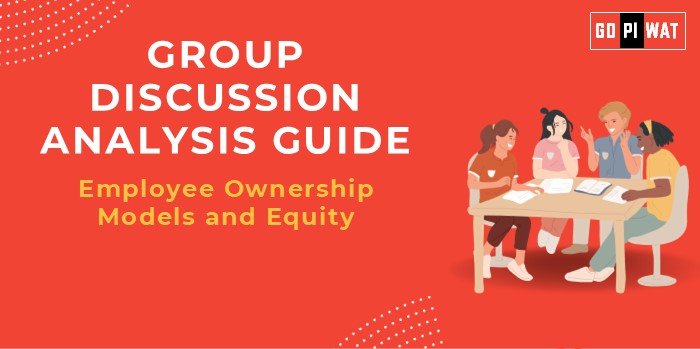📋 Group Discussion Analysis Guide: Employee Ownership Models and Equity
🌐 Introduction to the Topic
Opening Context: “As income inequality and employee dissatisfaction rise, innovative solutions like employee ownership models offer a pathway to equitable wealth distribution and greater organizational engagement.”
Topic Background: Employee ownership models, such as Employee Stock Ownership Plans (ESOPs) and worker cooperatives, provide employees with ownership stakes in companies. Originating in the mid-20th century, these models are gaining momentum globally as tools to promote equity, engagement, and shared prosperity in organizations.
📊 Quick Facts and Key Statistics
💰 Wealth Gap Impact: Companies with ESOPs show 92% higher median wealth for employees than non-ESOP peers (Rutgers Study, 2023).
📈 Employee Engagement: Organizations with shared ownership models report 15-20% higher productivity (Harvard Business Review, 2023).
🌍 Global Trend: 1,500+ employee-owned companies in the UK contribute £30 billion to the economy.
🇮🇳 India’s Growing Adoption: Startups like Zerodha distribute ownership through ESOPs to retain talent and align employee interests.
🤝 Stakeholders and Their Roles
- 💼 Employees: Gain financial benefits, motivation, and a sense of ownership, leading to higher productivity and retention.
- 🏢 Employers: Use ownership models to align workforce goals with company success and attract top talent.
- 🏛️ Governments: Encourage employee ownership through policies to reduce income inequality and boost wealth distribution.
- 📊 Investors: Benefit from long-term organizational stability and better performance driven by engaged employees.
🏆 Achievements and Challenges
✨ Achievements:
- ✔️ Improved Employee Wealth: ESOP companies like Publix Supermarkets in the US have significantly reduced employee wealth gaps.
- 📈 Enhanced Productivity: Studies show 20% higher output in employee-owned firms due to increased motivation.
- 🤝 Retention and Loyalty: Firms like Zerodha and Infosys leverage ESOPs to retain talent and reduce attrition.
- 🌐 Organizational Resilience: Employee-owned companies exhibit stronger financial resilience during economic downturns.
⚠️ Challenges:
- 💸 Initial Implementation Costs: Setting up ESOPs requires significant legal and administrative expenses.
- 📉 Equity Mismanagement: Unequal distribution or lack of financial education can dilute employee trust.
- ⏳ Short-term Profit Focus: Some firms prioritize immediate financial goals over long-term equity commitments.
🌎 Global Comparisons:
- 🇪🇸 Mondragon Corporation (Spain): A worker cooperative with over 80,000 employee-owners achieving strong economic performance.
- 🇬🇧 John Lewis Partnership (UK): A retailer owned entirely by its 80,000 employees, leading to high customer satisfaction and profit-sharing.
📚 Case Study:
- 📊 Zerodha’s ESOP Model: The Indian fintech firm distributes significant stock ownership to employees, fostering loyalty and aligning workforce goals with organizational success.
🗣️ Structured Arguments for Discussion
Supporting Stance: “Employee ownership models promote equity, enhance wealth distribution, and drive productivity by aligning employee goals with company success.”
Opposing Stance: “While equitable in theory, employee ownership models face challenges like implementation costs, equity mismanagement, and financial illiteracy.”
Balanced Perspective: “Employee ownership models, when implemented with transparency and financial education, offer an equitable solution for organizations, though challenges must be addressed for sustainable success.”
💡 Effective Discussion Approaches
- 📜 Opening Approaches:
- Statistical Start: “Companies with employee ownership models report 15-20% higher productivity, demonstrating the success of equitable frameworks.”
- Case Study Opening: “Mondragon Corporation in Spain showcases how employee ownership can drive both equity and organizational success.”
- 🛠️ Counter-Argument Handling:
- “Implementing ownership models is costly and impractical for small businesses.” Response: “With proper support and policies, even smaller organizations can implement phased ownership plans to promote equity.”
📈 Strategic Analysis of Strengths and Weaknesses
- 🏅 Strengths: Promotes equity, boosts engagement, improves financial stability, and reduces turnover.
- ⚠️ Weaknesses: High setup costs, risks of ownership dilution, and potential lack of financial education.
- 💡 Opportunities: Expanding adoption across SMEs and startups; aligning with ESG goals for sustainable growth.
- ⚡ Threats: Short-term profit-driven management and uneven global adoption.
🎓 Connecting with B-School Applications
- 📚 Real-World Applications: Projects analyzing ESOP frameworks in startups and multinational firms, case study evaluations of companies like John Lewis, Mondragon, and Zerodha.
- 💬 Sample Interview Questions:
- “How can employee ownership drive equity and performance in organizations?”
- “Discuss a successful company that uses employee ownership models.”
- 🔑 Insights for Students:
- Employee ownership models align with ESG goals and future workplace trends.
- Leadership requires balancing financial feasibility with equitable wealth distribution.


